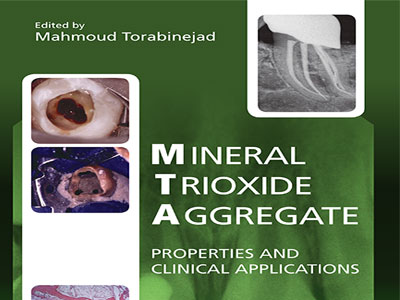Mineral Trioxide Aggregate
Author: Mahmoud Torabinejad
سال انتشار : 2014
زبان کتاب : انگلیسی
حجم کتاب : 16 مگابایت
فهرست عناوین
1
-
16
Pulp and Periradicular Pathways
- Natural Pathways
- Apical foramen
- Lateral canals
- Dentinal tubules
- Pathological and Iatrogenic Pathways
- Dental caries
- Role of microorganisms
- Root perforations
- Root perforations during access preparation
- Root perforations during cleaning and shaping
- Root perforations during post space preparations
- Vertical fracture
- Periradicular Pathosis
- Inflammatory process of periradicular lesions
- Materials to Seal the Pathways to the Root Canal System and the Periodontium
- References
17
-
36
- Introduction
- MTA Composition
- Portland cement
- Role of bismuth oxide and gypsum
- MTA powder morphology
- Trace elements and compounds
- Setting Reactions
- Setting time
- Maturation
- Factors that affect setting: additives and accelerants
- Effect of water and moisture
- Interaction with environment
- Development of Reaction Zones
- References
37
-
70
- Introduction
- pH
- Solubility
- Setting Expansion
- Radiopacity
- Various Types of Strength
- Compressive strength
- Flexural strength
- Shear strength
- Push-out strength
- Shear bond strength
- Overview
- Microhardness
- Color and Aesthetics
- Physicochemical Properties
- Acknowledgment
- References
71
-
110
- Introduction
- Advantages
- Pulp Responses to Capping Materials
- Direct Pulp Capping with Calcium Hydroxide
- Mineral Trioxide Aggregate
- Pulpotomy in Primary Teeth
- MTA Pulpotomy
- Pulp Capping in Teeth Diagnosed with Reversible Pulpitis
- Treatment Considerations
- Disadvantages
- Summary
- Acknowledgment
- References
111
-
140
- Diagnosis in Immature Teeth
- History of Treating Immature Teeth
- Infection Control in Immature Teeth
- Apexification
- Calcium Hydroxide Apexification Therapy: Outcomes
- Non-Vital Pulp Therapy
- References
141
-
176
- Introduction
- Revascularization after Replantation and Autotransplantation
- Revitalization of Nonvital-Infected Teeth in Animals
- Clinical Evidence for Revitalization in Nonvital-Infected
- Potential Role of Stem Cells in Canal Tissue Generation
- Clinical Procedures for Pulp Revitalization
- References
177
-
206
- Introduction
- Types of Perforation Defects
- Factors Influencing Prognosis for Repair
- Pulp Chamber Perforations
- Root Perforations During Cleaning and Shaping
- Root Perforation during Post Space preparation
- Techniques for Internal Repair Using MTA
- References
207
-
250
Introduction 208 Charactertics/Properties 210 Mechanisms of action in obturation 210 Particle size 211 Hydration products and pH 211 Formation of interstitial layer 212 Fracture resistance 212 Sealing ability and setting expansion 213 Applications/Uses 214 Conventional obturation 214 Retreatment 216 Obturation prior to surgery 219 Obturation with perforation repair 219
- Apexification using MTA obturation
- Obturation for dental anomalies
- Obturation Techniques
- Standard compaction technique
- Lawaty technique
- Auger technique
- Restorative Considerations
- Drawbacks
- Sealers
- Zinc oxide–eugenol sealers
- Calcium hydroxide sealers
- Epoxy resin-based sealers
- Glass ionomer sealers
- Silicone-based sealers
- Monoblock sealer systems
- Calcium silicate-based sealers
- Summary
- References
251
-
280
- Introduction of Root-End Filling Materials
- Purpose of root-end fillings
- History of Root-End Filling Materials
- Amalgam
- ZOE-based materials: IRM and SuperEBA
- Resin-based materials: Retroplast and Geristore
- Mineral trioxide aggregate (MTA)
- Gray vs. White MTA
- New types of MTA-like cements
- Requirements of Ideal Root-End Filling Materials
- Advantages and disadvantages of MTA as a root-end filling material
- Advantages of MTA
- Disadvantages of MTA
- MTA as a Root-End Filling Material
- Cytotoxicity and biocompatibility
- Bioactivity
- Sealability
- Antibacterial effect
- Clinical Applications of MTA
- Retropreparation and root-end filling
- Cavity preparation for MTA root-end filling
- Mixing procedure
- Methods for placement of MTA
- Clinical outcomes
- Conclusion
- References
281
-
362
- Introduction
- Portland Cement (PC)
- Angelus MTA
- Bioaggregate (BA)
- Biodentine (BD)
- iRoot
- Calcium Enriched Mixture (CEM) Cement
- MTA Fillapex
- Endo-CPM
- Cimento Endodontico Rapido (CER)
- Endosequence
- ProRoot Endo Sealer
- MTA Plus
- Ortho MTA
- MTA Bio
- MTA Sealer (MTAS)
- Fluoride-Doped MTA Cemen
- Capasio
- Generex A
- Ceramicrete-D
- Nano-Modified MTA (NMTA)
- Light-Cured MTA
- Calcium Silicate (CS)
- Endocem
- Other Experimental MTA Lookalike Mixtures
- Conclusion
- References

